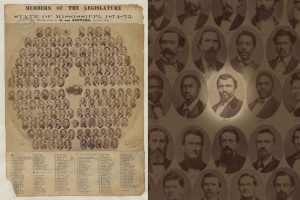By Crafton Beck
Jackson Advocate Guest Writer
Let’s say you were to ask an American in the 19th century, “What is American music?”
Keep in mind, by the way, that it was a time before “Broadway music” was born; “country and western” music would not be “a thing” until the 1940’s, and rock and soul would not appear until the 1950s! So, if you were to ask someone in 1890 to define American music, the answer would be regional. If you were in the Carolinas or Kentucky, for example, music would be the jigs, reels, and fiddlin’ music descended from the Scot and Irish immigrants; this music, in fact, would become Bluegrass and be one development towards country music. If you were out in the Plains states like Montana, Oklahoma, or Kansas, the answer would likely be “cowboy songs.” Most anywhere in the Midwest, your answer would be “the songs of Stephen Foster” (“Oh, Susanna,” “Camptown Races” and the like); in Chicago in 1890, it would certainly be “ragtime”; and in New Orleans, it would be that heady mix which twenty years later would be called “Dixieland.”
But what is amazing is that the last three of these – the essentially-minstrel songs of Stephen Foster, Chicago’s ragtime, the music of New Orleans’ jazz – all had their roots in African-American music.
In one of the great ironies of America’s cultural history, in one of the rare instances where justice is rendered in the natural course of things, it would be the music of Africa which would bring unity to this otherwise diverse American musical tapestry as it existed in 19th-century America. It was the music and dance brought here in the hearts and minds of men and women delivered here from Africa – a music with such distinctive rhythms, exceptional vocal stylings, its own sensibilities – which would, in the first quarter of the 20th century, unify American music into something distinctive and new. Without it, there would have been jazz, no rock, no soul, no Copland, no Gershwin, no Bernstein….
This music first manifested itself on the plantation as field songs and in spirituals, but by the turn of the century it was coalescing into a style with many of the characteristics we would today call “jazz”: provocative offbeat rhythms, a shuffle beat which sass and shimmy as much as it could saunter, and a deeply expressive melodic style you and I best know today in the Blues. Ultimately, Jazz is radical. It comes from disenfranchisement; it’s a music in the cracks, offbeat, and in-between. That’s why the pulse finds itself a shuffle and often offbeat. That’s why the notes themselves are bent – flattened, sharpened, and sliding – into something worn but new and deeply personal.
And in 1892, into all this came one of the great living European composers of the age: Antonin Dvorak. He had accepted an invitation to come to America to take up the Directorship of the National Conservatory of Music in New York City. More specifically, he had been brought to America to “create an American school of composition.” But it didn’t take him long to realize that there was no need to create an American school of composition: Americans just needed to listen and hear what they already had.
Within weeks of arriving, he had heard African-American spirituals, and he was fascinated with the music of Native Americans, which he also heard firsthand. Within a year, he wrote, “I find a sure foundation in the Negro melodies… In them, I discover all that is needed for a great and noble school of music … There is nothing in the whole range of composition that cannot be supplied with themes from this source.” And as a demonstration of all this, he wrote a new symphony, his ninth and last, his “New World” Symphony, which the Mississippi Symphony performed in the second half of the “Redefined: Celebrating Black American Music” concert on February 25. While Native American music is plainly apparent, especially in the third movement, it is the elements of Black American music which is so pervasive in almost every measure of the piece. Here it all is: continuous offbeat rhythms, walking basses, and Blues-like melodies.
Of course, history has since unfolded, and in the first half of the concert, we looked at American music 130 years on – Black American music of today through the eyes and ears of Nicholas Payton. He wrote his Black American Symphony just ten years ago as a symphonic interpretation of creating a work that would use a construct largely associated with the European aesthetic, but without relying on the European language. Instead, I used what Dvorak called “Negro melodies.” Nicholas had in part been inspired by Dvorak’s work 130 years ago. These two pieces, then – Dvorak’s “New World” and Nicholas’ “Black American Symphony” – are brothers/sisters, if you will, and we paired them intentionally to make a whole. They are of one piece.
Perhaps now Nicholas‘ music will inform Dvorak’s music for you. And perhaps, too, you will hear Dvorak’s music for the time capsule which it is, returning us in sound to what American music was on the threshold of the 20th century.
Crafton Beck is now in his twenty-first season as music director and conductor of the Mississippi Symphony Orchestra.






